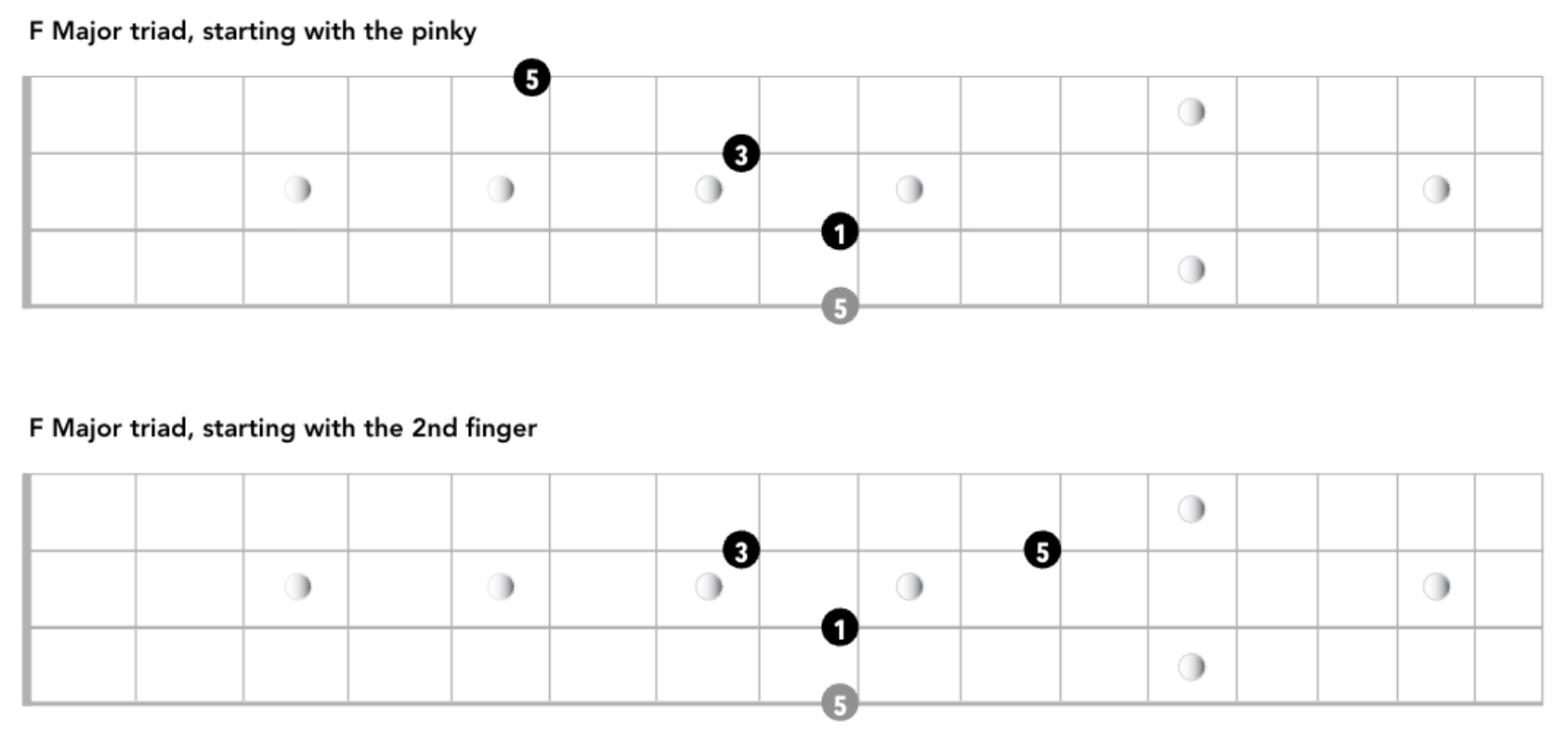My last post on fifths (when not to play the perfect fifths) and the one before on the forgotten fifth are hopefully still fresh in your memory because there is one additional really important thing to know about the fifths. And I consider it super important, because it sits at the root of Western harmony since the classical times. And it is super relevant because with all the liberties we get to take and modal music we get to do these days (in pop, funk, jazz, scores), that V-I connection is still a big deal.
Why is V-I so important?
Because when a V chord (especially a dominant seventh chord!) resolves to the I chord, it is all about tension and release!
Within the V7 chord is a tritone – a very tense interval. It is formed between the third and seventh scale degrees. When it resolves – typically to the root and third of the I chord (could be major or minor, that I chord), we go from tension (tritone!) to release (root and third sounds very stable).
Ever since (and even before) classical times, stories were told through harmonic tension and release. That’s why in classical theory books you see all this hubbub about the dominant and the subdominant (the main functions) and the sub-functions thereof. Every single chord I can create within a key by stacking thirds has a certain “function”. And the V chord is tension city. And the I chord is “home”.
Listen to it on the bass and watch for the fret board shapes: tension – release:
What does the bass do?
Let’s say we are in the key of C, where G7 is my V chord and C my I.
So while the tritone in G7 (B and F) resolves to the third in C (C and E), the bass (playing the root) goes from the V (G) to the I (C).
If you go from the V down to the I, that is considered a “falling fifth”.
You could of course also go from the G below to the C above. This is not such a strong resolution, but entirely fine. One reason why the following fifth feels like a stronger resolution is because of gravity. It is deeply ingrained in us that something that is higher up has more kinetic energy and more energy is being released when it falls to the ground. Lifting something up from the ground takes energy letting something fall to the ground releases it
Cycle of Fifths
Practicing and understanding the cycle is a great idea. It teaches you a lot about key signatures, correct note naming, sharps and flats and fret board harmony and how to play in all keys and it is super educational for the lay out of notes on the bass! For example: have you ever noticed that E – A – D – G is a slice out of the cycle?
I distinguish between practicing the diatonic cycle and the regular cycle, but that is for another post! Important here is that in a diatonic cycle you skip the notes that are not part of the key. But you are still stepping through steps like the cycle outlines!
Most important, the cycle (especially the diatonic one!) shows up in music everywhere. Lots of songs have V-I in them, but many also have II – V – I in them. Even IV – V – I (as in a blues!) is in the cycle: blues in G: has G C and D in it. Can you find the three in the cycle?
There are some songs that take the entire diatonic cycle to the right (ascending fifths):
- parts of Hotel California
for example.
But many more songs go “to the left”:
- Still got the Blues
- Autumn Leaves
- Europa Santana
- I will Survive
are examples of songs going through the entire diatonic cycle in minor;
- Fly me to the Moon
is an example for the cycle in major. So, when we practice the sequence of the cycle (especially the diatonic cycle! And especially counter clockwise!), we practice something very practical.
The Cycle of Fifths versus the Cycle of Fourths?
Fourths and Fifths are inversions of each other. So if I ascend a fifth by going clockwise in the cycle, I might be tempted to say, okay now, if I practice the cycle counterclockwise, I go in ascending fourths, so I am actually practicing the “Cycle of Fourths”.
By calling it that, however, you really miss the entire point of this crucial bass movement. It would be much more fitting to call it the Cycle of descending Fifths.
Because, check it out:
- C7 is the V of F
- F7 is the V of Bb
- Bb7 is the V of Eb…
See it in the cycle? I added purple V -> Is into it, so you can see it clearly.

And that is exactly the reason that when you practice this sequence it feels like you are running down a hill and cannot stop!
Because each note pushes into the next… another V – I ad infinitum, you can go round and round and round 🙂
Please don’t call it the cycle of fourths. It is the cycle of descending fifths.
Or the “circle” if you will. But Carol Kaye told me once that that outed you as a classical person in the 60s and that to be hip it’s the “cycle”. Cycle it is!
Cycle of falling fifths, cool?








14 Replies to “Please Don’t Call it the “Cycle of Fourths””
Ari, this is amazing! You have righted my ship of theory with this profound article.
Problem began with Sound of Music–Do-Re-Mi, not Do-Ti-La… I had learned and practiced every scale upward from the root, so intervals must ascend!
Also, US northeast major music school uses shorthand: Cycle 4ths. I took this literally.
But nevermore! Falling Fifths it is, on the Cycle 5!
Thank you Warren, yes, a small difference in naming, but a profound difference in experience. Keep cycling away 🙂
Mmmm, in the SBL academy there is a masterclass by Phill Mann where he is talking about the circle of fourths?
Phil is an awesome teacher and player! If you read my article you see my argumentation for my reasoning. I am aware that many people call it the cycle of fourths and while we still clearly understand what is meant by that I illuminate theory reasons that point to naming it fifth which teaches you about fundamental forces underlying music theory.
It depends on the key – if you are in C and start on D, then you descend in fifths D-G-C, but if you are in C and go C-F-Bb, then you are moving in 4ths.
Both of these movements can be seen as falling fifths or ascending fourths. If you are just writing it as letter names like that you are not specifying if you are ascending or descending. The underlying harmonic experience is still that of a falling fifth progression.
Hello Ari, I’m just a beginner bass player and lack the background in music; this is why purchased your book and the tutorial program. I appreciate the extra articles and tips you add to the website. When you create a chart or diagram, would it be possible for you to please convert it to a file that we can download, then we are able to make a hardcopy(s). Thank you for your time. Take care.
Hi David, welcome to the world of bass! Thank you for your nice comments. To download any of the pictures on the blog just grab and pull on your desktop. If you are referring to the 130 PDFs in the course, they can be downloaded in the OUTRO tab of each unit.
David if your using a Windows machine you can always do a “print screen” which saves it to the “Screenshot” folder in the pictures folder. Just hold down the “Windows” button and then press the “PrtScn” button, you’ll see your screen go dark for a second which means you got it.
Stinkin awesome! I just read Aris blog for 30 minutes randomly… I feel like I stayed at a Holiday Inn last night! Smart gal…
hi Ari, interesting. Do you know any resources where I can read about other cycles, like the cycles of major/minor thirds, seconds, etc. … ? Any help would be appreciated! Thanks!
I make a blog post of it. Check Giant Steps for major thirds cycle for example. Classical theory books talk about mediant relationships, that is thirds.
Although, as your mention, music tends to move in descending fifths, rather than ascending fifths, would you still suggest practising the Circle in both directions–both ascending and descending? Or, would practice be better spent doing just the descending fifths and working on other stuff. Thanks, Sam
Yes, by all means! Also in 2 groupings of 6 whole steps, 3 groupings of minor thirds or four groupings of major thirds as well as in half steps. The above list makes it progressively harder because more and more notes change between keys. All of these shifts appear in music.